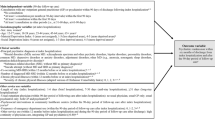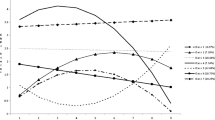Abstract
Time to psychiatric rehospitalization was predicted for a sample of 1473 Medicaid-insured youth in Illinois in 2005 and 2006. A multi-level model statistical strategy was employed to account for the fact that youth days to rehospitalization were nested within hospital and to test the hypothesis that hospitals would vary significantly in return rates, controlling for individual-level (e.g., symptom, demographic) variables. Hospitals did not vary significantly in days to rehospitalization. At the individual-level, level of externalizing behavior and residential treatment placement predicted a faster return to the hospital. These results support the perspective that hospital outcomes are best operationalized using variables tied more directly to the inpatient episode (e.g., LOS, reductions in acuity).
Similar content being viewed by others
References
Adair, C. E., McDougall, G. M., Beckie, A., Joyce, A., Mitton, C., Wild, C. T., et al. (2003). History and measurement of continuity of care in mental health services and evidence of its role in outcomes. Psychiatric Services, 54, 1351–1356.
American Psychiatric Association. (2013). Diagnostic and statistical manual of mental disorders (5th ed.). Arlington, VA: American Psychiatric Publishing.
Arnold, E. M., Goldston, D. B., Ruggiero, A., Reboussin, B. A., Daniel, S. S., & Hickman, E. A. (2003). Rates and predictors of rehospitalization among formerly hospitalized adolescents. Psychiatric Services, 54, 994–998.
Barth, R. (2002). Institutions vs. foster homes: The empirical base for a century of action. Chapel Hill, NC: University of North Carolina, School of Social Work, Jordan Institute for Families.
Bates, B., English, D., & Kouidou-Giles, S. (1997). Residential treatment and its alternatives: A review of the literature. Child & Youth Care Forum, 26, 7–51.
Bickman, L., Foster, E. M., & Lambert, W. (1996). Who gets hospitalized in a continuum of care? Journal of the Academy of Child and Adolescent Psychiatry, 35, 74–80.
Blader, J. C. (2004). Symptom, family, and service predictors of children’s psychiatric rehospitalization within one year of discharge. Journal of the American Academy of Child and Adolescent Psychiatry, 43, 440–451.
Bobier, C., & Warwick, M. (2005). Factors associated with readmission to adolescent psychiatric care. Australian and New Zealand Journal of Psychiatry, 39, 600–606.
Burns, B. J., Hoagwood, K., & Mrazek, P. J. (1999). Effective treatment for mental disorders in children and adolescents. Clinical Child and Family Psychology Review, 2, 199–254.
Burns, B. J., Phillips, S. D., Wagner, H. R., Barth, R. P., Kolko, D. J., Campbell, Y., et al. (2004). Mental health need and access to mental health services by youths involved with child welfare: A national survey. Journal of the American Academy of Child and Adolescent Psychiatry, 43, 960–970.
Byrne, S. L., Hooke, G. R., & Page, A. C. (2010). Readmission: A useful indicator of the quality of inpatient psychiatric care. Journal of Affective Disorders, 126, 206–213.
Carlisle, C. E., Mamdani, M., Schachar, R., & To, T. (2012). Aftercare, emergency department visits, and readmission in adolescents. Journal of the American Academy of Child and Adolescent Psychiatry, 51, 283–293.
Case, B. G., Olfson, M., Marcus, S. C., & Siegel, C. (2007). Trends in the inpatient mental health treatment of children and adolescents in the US community hospitals between 1990 and 2000. Archives of General Psychiatry, 64, 89–96.
Chung, W., Edgar-Smith, S., Baugher Palmer, R., Bartholomew, E., & Delambo, D. (2008). Psychiatric rehospitalization of children and adolescents: Implications for social work intervention. Child and Adolescent Social Work Journal, 25, 483–496.
Cox, D. R. (1972). Regression models and life tables (with discussion). Journal of the Royal Statistical Society: Series B, 34, 187–220.
Department of Health and Human Services. (2011). Details for Community based Care Transition Program. Washington (DC): HHS.
Durbin, J., Lin, E., Layne, C., & Teed, M. (2007). Is readmission a valid indicator of the quality of inpatient psychiatric care? Journal of Behavioral Health Services & Research, 34, 137–150.
Fite, P. J., Stoppelbein, L., Greening, L., & Dhossche, D. (2008). Child internalizing and externalizing behavior as predictors of age at first admission and risk for repeat admission to a child inpatient facility. American Journal of Orthopsychiatry, 78, 63–69.
Fontanella, C. (2008). The influence of clinical, treatment, and healthcare system characteristics on psychiatric readmission of adolescents. American Journal of Orthopsychiatry, 78, 187–198.
Fontanella, C. A., Pottick, K. J., Warner, L. A., & Campo, J. V. (2010). Effects of medication management and discharge planning of early readmission of psychiatrically hospitalized adolescent. Social Work in Mental Health, 8, 117–133.
Foster, E. M. (1999). Do aftercare services reduce inpatient psychiatric readmissions? Health Services Research, 34, 715–736.
Gifford, E., & Foster, E. M. (2008). Provider-level effects on psychiatric inpatient length of stay for youth with mental health and substance abuse disorders. Medical Care, 46, 240–246.
Gorsuch, R. L. (1974). Factor analysis. Philadelphia: W. B. Saunders Company.
Hermann, D. (1997). Mental Health and Disability Law. Minnesota: West Publishing.
James, S., Charlemagne, S. J., Gilman, A. B., Alemi, Q., Smith, R. L., Tharayil, P. R., & Freeman, K. (2010). Post-discharge services and psychiatric rehospitalization among children and youth. Administration and Policy In Mental Health, 37, 433–445.
Lapointe, A. R., Garcia, C., Taubert, A. L., & Sleet, M. G. (2010). Frequent use of psychiatric hospitalization for low-income, inner-city ethnic minority youth. Psychological Services, 7, 162–176.
Leon, S. C. (2008). Understanding psychiatric hospital admissions and outcomes. In Lyons & Weiner (Eds.), Behavioral Healthcare Strategies: Total Clinical Outcomes Management (pp. 9.1–9.13). New Jersey: Civic Research Institute, Inc.
Leon, S. C., Snowden, J., Bryant, F. B., & Lyons, J. S. (2006). The hospital as predictor of children’s and adolescents’ length of stay. Journal of the American Academy of Child and Adolescent Psychiatry, 45, 322–328.
Leon, S. C., Uziel-Miller, N. D., Lyons, J. S., & Tracy, P. (1999). Psychiatric hospital service utilization of children and adolescents in state custody. Journal of the American Academy of Child and Adolescent Psychiatry, 38, 305–310.
Lyons, J. S. (1997). The Measure and Management of Clinical Outcomes in Mental Health. New York: Wiley.
Lyons, J. S., Rawal, P., Yeh, I., Leon, S. C., & Tracy, P. (2002). Use of audits in outcomes management. Journal of Behavioral Health Services Research, 29, 75–80.
Lyons, J. S. (2004). Redressing the emperor: Improving our children’s public mental health system. Westport, CT: Prager.
Maas, C. J. M., & Hox, J. J. (2005). Sufficient sample sizes for multilevel modeling. Methodology, 1, 86–92.
Muthén, L. K., & Muthén, B. O. (2013). Mplus version 7.01 [Computer program]. Los Angeles: Muthén & Muthén.
Paccagnella, O. (2011). Sample size and accuracy of estimates in multilevel models: New simulation results. Methodology: European Journal of Research Methods for the Behavioral and Social Sciences, 7(3), 111.
Pavkov, T. W., George, R. M., & Lee, B. J. (1997). State hospital reentry among youth with serious emotional disturbance: A longitudinal analysis. Journal of Child and Family Studies, 6, 373–383.
Preacher, K. J., & MacCallum, R. C. (2003). Repairing Tom Swift’s electric factor analysis machine. Understanding Statistics, 2, 13–32.
Romansky, J. B., Lyons, J. S., Lehner, R. K., & West, C. M. (2003). Factors related to psychiatric hospital readmission among children and adolescents in state custody. Psychiatric Services, 54, 356–362.
Rosenau, P. V., & Linder, S. H. (2003). A comparison of the performance of for-profit and nonprofit U.S. psychiatric inpatient care providers since 1980. Psychiatric Services, 54, 183–187.
Singer, J. D., & Willett, J. B. (2003). Applied longitudinal data analysis: Modeling change and event occurrence. New York: Oxford University Press.
Stewart, S. L., Kam, C., & Baiden, P. (2014). Predicting length of stay and readmission for psychiatric inpatient youth admitted to adult mental health beds in Ontario, Canada. Child and Adolescent Mental Health, 19, 115–121.
Thakur, N. M. (1998). Remission as an indicator of quality of care [Letter to the editor]. The American Journal of Psychiatry, 155, 447.
Wickizer, T. M., Lessler, D., & Boyd-Wickizer, J. (1999). Effects of health care cost-containment programs on patterns of care and readmissions among children and adolescents. American Journal of Public Health, 89, 1353–1358.
Yampolskaya, S., Mowery, D., & Dollard, N. (2013). Predictors for remission into children’s inpatient mental health treatment. Community Mental Health Journal, 49, 781–786.
Author information
Authors and Affiliations
Corresponding author
Rights and permissions
About this article
Cite this article
Leon, S.C., Stoner, A.M. & Dickson, D.A. Does the Hospital Predict Readmission? A Multi-level Survival Analysis Approach. Adm Policy Ment Health 43, 514–523 (2016). https://doi.org/10.1007/s10488-015-0654-9
Published:
Issue Date:
DOI: https://doi.org/10.1007/s10488-015-0654-9




